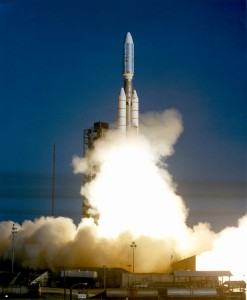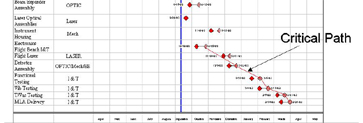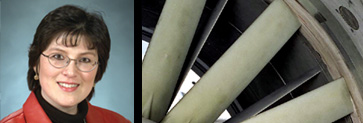
You’ve been with JPL for 41 years. What were some of the early lessons you learned from the project managers you worked under?
The technical challenges in those early days were immense. I learned from the early practitioners in the space program, such as John Casani, Bill Shipley, and Casey Mohl. They were all bright, disciplined thinkers who emphasized understanding problems in great technical depth. In fact, we’re still following the principles that they laid down 40 years ago.
When you addressed the Return to Flight team last year, you emphasized the importance of forging new leadership for NASA’s space flight missions. How have you set out to accomplish that?
What is something that you learned from them that you still use today?
Casey, for instance, would have coffee every morning in the cafeteria at 7:15 a.m. Everyone was welcome to come, sit down, have coffee, and ask questions. Guess what I do? People know that I come in to the cafeteria around 7:30 a.m., and, if they want to talk, they know where they can find me.
Do you remember making mistakes or having missteps when you were working for any of those legendary project managers? If so, how did they respond?
I was the mission assurance manager for the Voyager project and John Casani was the project manager. Casani has a very systematic approach in examining issues or problems. When you had to present a problem and the potential solution, Casani would very quickly work the discussion to the boundary of your understanding of the issue. He always worked it with you so that you were discovering the soft spots in your solution. It was always a constructive learning experience with Casani.
So, the response wasn’t to slap you down?
No. It was very much to help me. I had the opportunity of a terrific on-the-job learning experience.
So, you got to see the processes modeled?
Yes. I learned incrementally. I absorbed it all, piece by piece. I didn’t really have to think about what I needed to learn; I was lucky enough to see it modeled over time.
We recognize that in today’s environment of short development schedules, engineers don’t necessarily have the luxury of incremental learning. With new projects frequently on the horizon, we need to supplement their hands-on experience with training.
To that end, we at JPL have compiled many years of experience in our Flight Project Practices and Design Principles and we have developed a project manager’s class — where the role and responsibilities of project management are explained to newly appointed and prospective project managers. This class is popular and provides a detailed look into the life of a project manager. As a result of this class, we have increased our pool of engineers ready for a project manager assignment, and we have also had engineers recognize that project management may not be for them. This unexpected outcome from this class is beneficial to both the employees and the Laboratory.
As someone whose responsibility it is to groom project managers, what do you look for? What do you expect in people who want to be project managers?
First of all, they must have the necessary technical and leadership skills and personal integrity.
You also must be able to inspire the confidence of the project team who is going to work for you. Take Pete Theisinger, the project manager of the Mars Exploration Rover, for example. He took on the job of launching two spacecraft from a dead start in 37 months. His team members had to have faith that he was going to lead them and look after them. Those are the qualities that I look for.
How do you spot the real leaders?
You have to watch their careers. What challenges have they faced? What commitments have they made and have they met those commitments? What have they delivered? In many ways, this is a natural selection process. Around here, if you say you want to be a project manager, the first question is always going to be: What experience do you have? What have you delivered?
The fact that you want to be a project manager doesn’t mean you are going to get the job. Part of the experience set for a project manager has to be delivery responsibility — what have you delivered successfully? Did you do it on time? Did you do it on money, be it hardware or software?
In addition to delivery experience, we are looking for the total package. How were your communications skills? How did you deal with problems? How did you deal with stress? It’s those kinds of things.
As you were going through that process yourself, was there a point where you said, “This is going to make or break me”?
Sure — again, for me it was Voyager. I was named mission assurance manager when I was 30 years old, and I was on the mission until it launched in 1977. Because of my work in the first couple years of the project, I was given responsibility for the radiation hardening of the spacecraft from all of the mission’s electronics. They said, “Okay, you go do this job.” I had that development responsibility from 1974 until launch.
Voyager leveraged everything in the rest of my life at JPL. On the other hand, if Voyager had not gone well, they might very well have said, “Well, we saw what he did.”
At the time, did you think you were in a little over your head?
I thought I was in way over my head. I was thinking, “You want me to do what?” Voyager was a real stretch for me.
Don’t you think there’s irony here? One of the things you’re talking about is making certain that people are prepared to advance to the next level. On the other hand, you’re talking about stretching, about making a leap.
That’s right. You’ve got to make people stretch a little. I decided early on that I love to run scared. Someone said to me once, “Why would you want to run scared?” I said, “Because it makes me think of all the things that could go wrong, so I can deal with them before they do.” Voyager was my biggest stretch. With the Cassini project, on the other hand, there was no reason that I couldn’t do well with that. I was the spacecraft manager for Cassini, and by that time I was well prepared for it.
I’m sure you still found a way to scare yourself.
I did. Before Cassini, I had always worked on the technical side of the house, where the emphasis was on meeting the engineering requirements first and foremost. Cost was secondary. Now I had a different role. That was the first time on a project that I had to manage the money, and it was definitely a stretch in that sense. So, I poured a lot of effort into learning about cost estimating and cost performance. I stumbled for a while but ultimately succeeded.
But in the end you returned money on Cassini. How did you manage that?
Some people will argue that we just had a lot of money to work with. I would say we were disciplined. From the start on Cassini, I knew what reserves we had for the spacecraft. The budget was $611 million, and $71 million of that was reserve. We made a series of decisions about how we would implement the project, and what type of management systems we would put in place to make certain we understood where the money was.
We did a lot of fixed-price contracting, for example. So, we said, “Let’s make sure we get the requirements right the first time, because if we fix-price this and then we go back and change requirements, we’re going to hemorrhage money.” Some of the contractors bet that we couldn’t discipline ourselves, but we did. We spent the first two years of the project making certain we understood the requirements and had the right design.
So, you delivered the goods. Then you had to leave the project when it was time for operations. How does it feel to hand off a project to someone else?
You just walk away from it. You get the new management ready, and then you walk away.
It was interesting with Cassini because as we were approaching the launch, I would warn the younger staff, “You’re about to experience a feeling of separation.” There were as many as 700 of them on the project team at one point. I would say to them, “You’ve been working now for five or six years with all of these people. You’re a part of this great Cassini team here at JPL. We’re going to launch it, and then all of this is going to go away. You’re going to have a sense of loss. You need to be prepared for that.”
How was it for you, personally?
Actually, when we came back from Cassini, it was kind of funny. Just imagine it: You’re the leader of the band. You’ve got everybody watching you. You’re down at the Cape. You’ve got the headphones on and you’re launching the spacecraft. Everybody is cheering and high-fiving, right?
Then I get back to JPL and walk into my office. Do you know what I saw in the office? Boxes and boxes and boxes. The guy who was the manager for operations came by and said, “Hi, welcome back. When can you be out of here?”
When I came back from Voyager, it was the same thing. I had been down at the Cape for four months. I showed back up at JPL, walked up to the Voyager Missions Support area and my badge wouldn’t work. I rang the bell. The girl said to me, “Can I help you? Who are you and why are you here?”
So, I guess the only way to get through that is to find the next project?
That’s right. Projects end. That’s our reality. But I love it. Listen, we are privileged. Everybody who works for this agency is privileged. We’re privileged to serve the American people the way we do. It sounds corny, but look at what the American people have allowed us to do. We need to do our very, very best. We should kick our personal interests aside. We’re doing these things in the name of science and for the American people. I never forget that.
Search by lesson to find more on:
- Professional Growth
- Leadership










